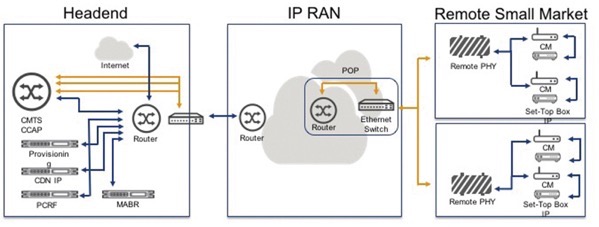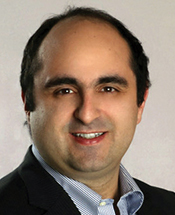Distributed Access Architectures Enable Services in Small Markets
By Patricio Latini
For many years, traditional hybrid fiber/coax (HFC) networks required significant infrastructure to launch service in a new market. To launch in a new geography, the cable operator required a physical building to host a hub or headend site, video and data distribution equipment, such as encoders, transcoders, edge-QAM modulators, CMTSs, optical transmission and combining, and finally power and cooling infrastructures.
Technological advances such as the converged cable access platform (CCAP) give operators some relief by consolidating functions and alleviating associated rack space and power headaches. Optical aggregation technologies, such as virtual hubs that rely on DWDM to serve multiple nodes from a distant headend, provide a viable solution but at the expense of dark fiber and costly optics.
These issues severely limited HFC deployments in small markets or isolated rural areas. Now, distributed access architectures (DAA), specifically remote PHY, is changing the game for service providers. DAA uses IP as the transport between the remote nodes and cores with cost effective 10 gigabit Ethernet as the optical interconnect. Deployed with DAA nodes-only, small markets can now be served from an I-CCAP or vCCAP core tens or hundreds of miles away. A local hub or headend site in the small market is no longer needed.
As an initial success case, Casa Systems worked with a Tier 1 MSO in Latin America in a first office application (FOA) which started in early 2018. The FOA consisted of five remote PHY devices (RPDs) in a remote city delivering video and high speed data (HSD) services. The remote city did not have dedicated dark fiber. The only connection between the main city with the CCAP core and the remote city was a 10 Gbps MPLS link that had to be shared with mobile backhaul traffic.
Additionally, the operator did not have a physical site suitable for a hub or headend. The only option was a mobile tower site with one rack unit where a 48 port 10 gigabit Ethernet switch with optical SFPs could be installed and act as an aggregation point for the links coming from the RPDs as shown in Figure 1.

Figure 1
Over the course of the FOA, it was demonstrated that convergent voice, video and data services, using 56 linear broadcast digital video channels plus 32 DOCSIS 3.0 narrowcast data channels per node, could be supported over a 10 Gbps video link. In fact, the traffic required to support the RPDs serving more than 150 HSD subscribers just exceeded 6 Gbps, which allowed more than enough capacity to add incremental mobile backhaul traffic.
The FOA provided some very important lessons:
- The use of multicast allowed for a significant reduction in the required bandwidth for broadcast video distribution to the nodes.
- The installation of RPDs required a new set of monitoring tools and processes along with technician training to adapt to the new network technology.
- The remote PHY deployment provided a quality of service and uptime equal or better than the traditional HFC network.
- The operator was able to serve a new, remote city without the acquisition of a physical site and associated network infrastructure.
- It was possible to share transport between the cable R-PHY link and a mobile backhaul link.
For many years, the paradigm for operators centered on building robust hub and headend sites which served as strategic interconnection points. Now, with new possibilities made possible by DAA and an all IP infrastructure, operators can shift the paradigm to a hybrid model and reap the benefits of leaner hubs and RPDs to expand their networks into areas that were formerly deemed unreachable.

Patricio Latini
Principal Technologist,
Casa Systems
Patricio Latini is the Principal Technologist for Caribbean and Latin America at Casa Systems overseeing the company’s technological strategy for its Latin America Region. Latini has over 20 years of experience in the cable industry and has held various leadership roles within the network strategy, engineering and technology domains. In addition, he is an experienced speaker at industry conferences and an accomplished writer with more than 20 technical articles on various network trends and strategies.


